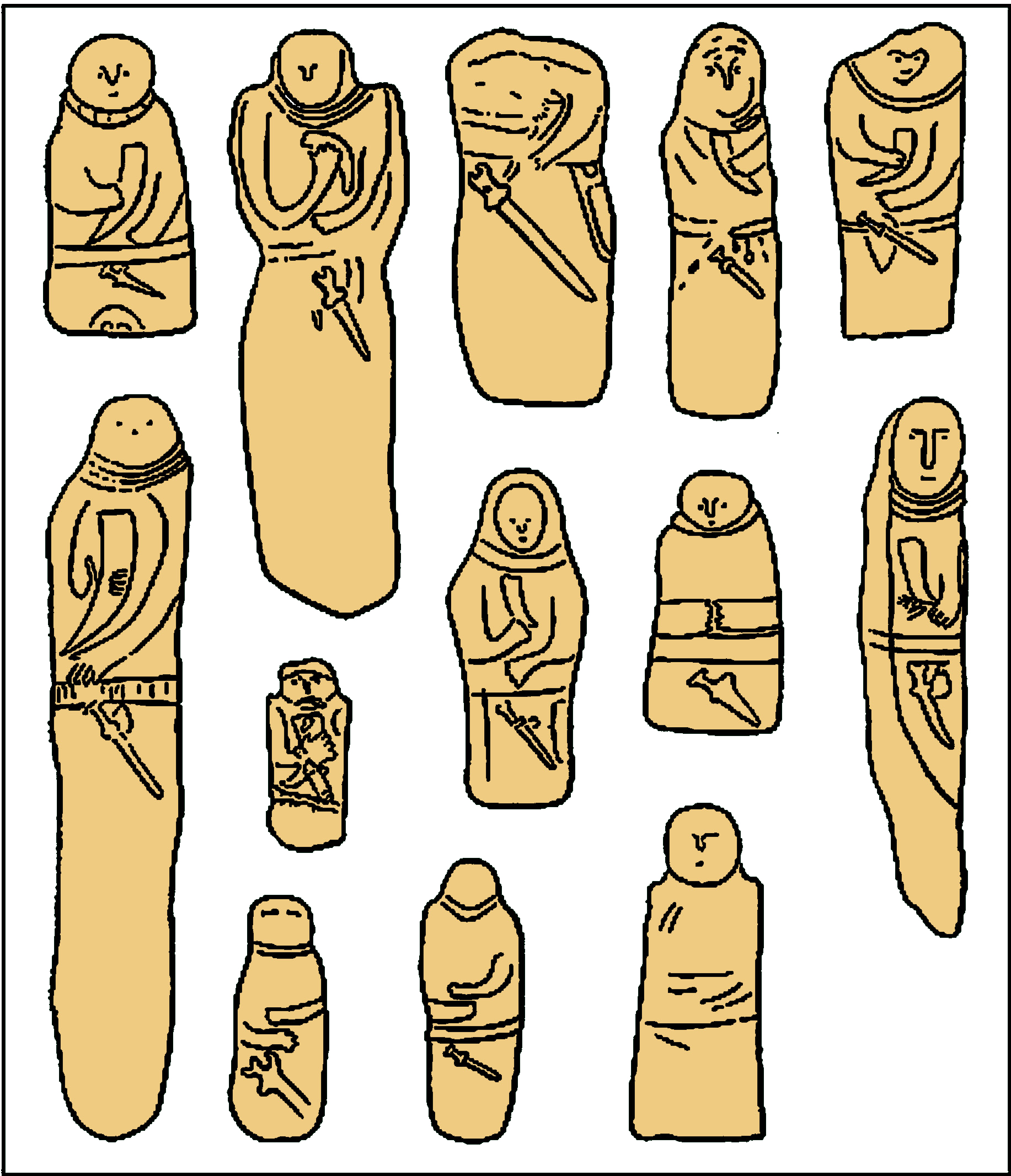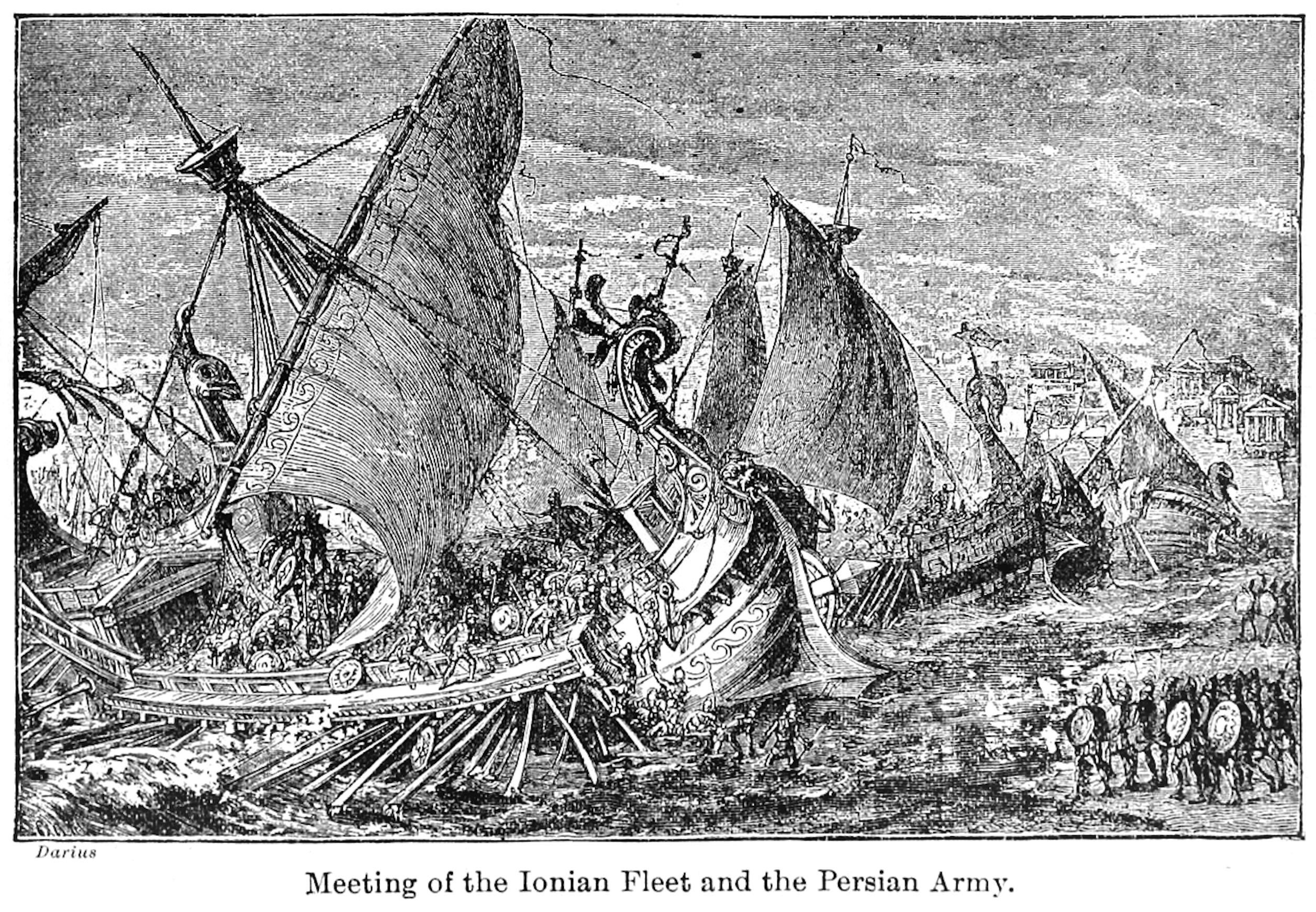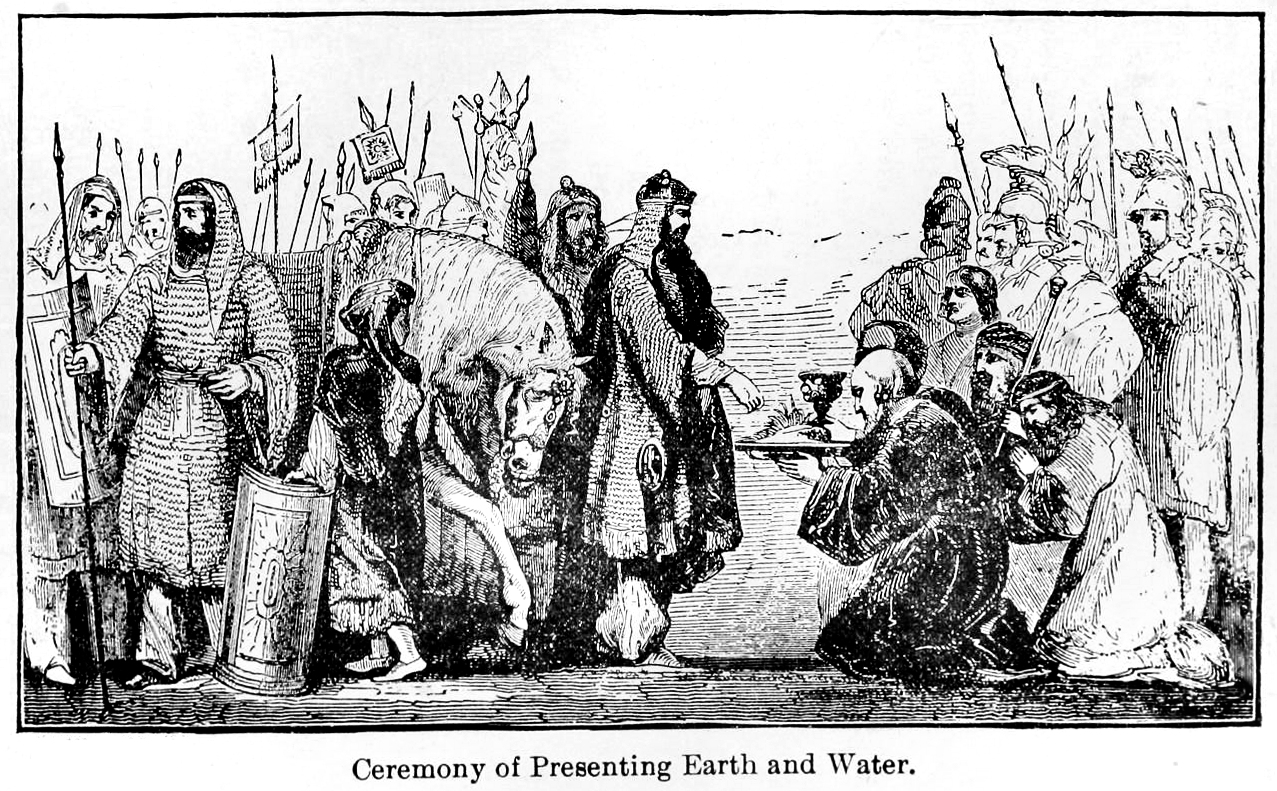|
Idanthyrsus
Idanthyrsus (Ancient Greek: , romanized: ; Latin: ) is the name of a Scythian king who lived in the 6th century BCE, when he faced an invasion of his country by the Persian Achaemenid Empire. Name and etymology The name () is the Hellenized form of a Scythian name whose original form is not attested. The Scythian name has been tentatively suggested by Ferdinand Justi and Josef Markwart to have been composed of the Iranian term "finding, attaining" or ; the linguist Alexis Manaster Ramer has reconstructed it as or , or as or , meaning "prospering the ally", with the final part modified into , referring to the composite vegetal wand of Bacchus, in Greek because the ancient Greeks associated Scythian peoples with Bacchic rites. Life Background Idanthyrsus was the son of his predecessor, the Scythian king Saulius, who was himself the brother and slayer of Anacharsis. Persian invasion When Darius I of Persia invaded Scythia, about 513 BC, and the Scythians retreated before hi ... [...More Info...] [...Related Items...] OR: [Wikipedia] [Google] [Baidu] |
Scythians
The Scythians or Scyths, and sometimes also referred to as the Classical Scythians and the Pontic Scythians, were an Ancient Iranian peoples, ancient Eastern Iranian languages, Eastern * : "In modern scholarship the name 'Sakas' is reserved for the ancient tribes of northern and eastern Central Asia and Eastern Turkestan to distinguish them from the related Massagetae of the Aral region and the Scythians of the Pontic steppes. These tribes spoke Iranian languages, and their chief occupation was nomadic pastoralism." * : "Near the end of the 19th century V.F. Miller (1886, 1887) theorized that the Scythians and their kindred, the Sauromatians, were Iranian-speaking peoples. This has been a popular point of view and continues to be accepted in linguistics and historical science [...]" * : "From the end of the 7th century B.C. to the 4th century B.C. the Central- Eurasian steppes were inhabited by two large groups of kin Iranian-speaking tribes – the Scythians and Sarmatians [.. ... [...More Info...] [...Related Items...] OR: [Wikipedia] [Google] [Baidu] |
Scythian Religion
The Scythian religion refers to the mythology, ritual practices and beliefs of the Scythian cultures, a collection of closely related ancient Iranian peoples who inhabited Central Asia and the Pontic–Caspian steppe in Eastern Europe throughout Classical Antiquity, spoke the Scythian languages, Scythian language (itself a member of the Eastern Iranian languages, Eastern Iranian languages, Iranian language family), and which included the Scythians, Scythians proper, the Cimmerians, the Sarmatians, the Alans, the Sindi (people), Sindi, the Massagetae and the Saka. The Scythian religion is assumed to have been related to the earlier Proto-Indo-Iranian religion as well as to contemporary Eastern Iranian and Ossetian mythology, Ossetian traditions, and to have influenced later Slavic mythology, Slavic, Hungarian mythology, Hungarian and Turkic mythology, Turkic mythologies. Development The Scythian religion was of Ancient Iranian religion, Iranian origin. The religion was influenced ... [...More Info...] [...Related Items...] OR: [Wikipedia] [Google] [Baidu] |
Ariapeithes
Ariapeithes (Scythian: ; Ancient Greek: , romanized: ) was a king of the Scythians in the early 5th century BCE. Name Ariapeithes's name originates from the Scythian name , and is composed of the terms , meaning “Aryan” and “Iranian,” and , meaning “decoration” and “adornment.” Life had three wives, each of whom bore him one son: *an unnamed Greek woman from , who became the mother of *an unnamed daughter of the Thracian king Tērēs I, who became the mother of *a Scythian woman named (Ancient Greek: , romanized: ; Latin: ), who became the mother of (Ancient Greek: , romanized: ; Latin: ) Death was treacherously killed by , the king of the Agathyrsi The Agathyrsi (Ancient Greek: ; Latin: ) were a people belonging to the Scythian cultures. The Agathyrsi were a people of mixed Iranian Scythic and Geto-Thracian origin whose bulk were Thracian while their aristocracy was closely related to the ..., after which became the king of the Scythians, and too ... [...More Info...] [...Related Items...] OR: [Wikipedia] [Google] [Baidu] |
Tabiti
The Scythian religion refers to the mythology, ritual practices and beliefs of the Scythian cultures, a collection of closely related ancient Iranian peoples who inhabited Central Asia and the Pontic–Caspian steppe in Eastern Europe throughout Classical Antiquity, spoke the Scythian languages, Scythian language (itself a member of the Eastern Iranian languages, Eastern Iranian languages, Iranian language family), and which included the Scythians, Scythians proper, the Cimmerians, the Sarmatians, the Alans, the Sindi (people), Sindi, the Massagetae and the Saka. The Scythian religion is assumed to have been related to the earlier Proto-Indo-Iranian religion as well as to contemporary Eastern Iranian and Ossetian mythology, Ossetian traditions, and to have influenced later Slavic mythology, Slavic, Hungarian mythology, Hungarian and Turkic mythology, Turkic mythologies. Development The Scythian religion was of Ancient Iranian religion, Iranian origin. The religion was influenced ... [...More Info...] [...Related Items...] OR: [Wikipedia] [Google] [Baidu] |
European Scythian Campaign Of Darius I
The Scythian campaign of Darius I was a military expedition into parts of European Scythia by Darius I, the king of the Achaemenid Empire, in 513 BC. The Scythians were an East Iranian-speaking people who had invaded Media, revolted against Darius and threatened to disrupt trade between Central Asia and the shores of the Black Sea as they lived between the Danube and Don Rivers and the Black Sea. The campaigns took place in parts of what is now the Balkans, Ukraine, and southern Russia. The Scythians managed to avoid a direct confrontation with the Persian army due to their mobile lifestyle and lack of any settlement (except Gelonus), while the Persians suffered losses due to the Scythians' scorched earth tactic. However, the Persians conquered much of their cultivated lands and damaged their allies, forcing the Scythians to respect the Persian force. Darius halted the advance to consolidate his gains, and built a defence line. The campaign Darius crossed the Black Sea at the B ... [...More Info...] [...Related Items...] OR: [Wikipedia] [Google] [Baidu] |
Darius I Of Persia
Darius I ( peo, 𐎭𐎠𐎼𐎹𐎺𐎢𐏁 ; grc-gre, Δαρεῖος ; – 486 BCE), commonly known as Darius the Great, was a Persian ruler who served as the third King of Kings of the Achaemenid Empire, reigning from 522 BCE until his death in 486 BCE. He ruled the empire at its territorial peak, when it included much of Western Asia, parts of the Balkans (Thrace– Macedonia and Paeonia) and the Caucasus, most of the Black Sea's coastal regions, Central Asia, the Indus Valley in the far east, and portions of North Africa and Northeast Africa including Egypt (), eastern Libya, and coastal Sudan. Darius ascended the throne by overthrowing the legitimate Achaemenid monarch Bardiya, whom he later fabricated to be an imposter named Gaumata. The new king met with rebellions throughout his kingdom and quelled them each time; a major event in Darius' life was his expedition to subjugate Greece and punish Athens and Eretria for their participation in the Ionian Revolt. Althou ... [...More Info...] [...Related Items...] OR: [Wikipedia] [Google] [Baidu] |
Išpakaia
Ishpakaia (Scythian ; Akkadian: ) was a Scythian king who ruled during the period of the Scythian presence in Western Asia in the 7th century BCE. Name is the Akkadian form of the Scythian name , which was a hypocorostic derivation of the word , meaning "dog." Historical background In the 8th and 7th centuries BCE, a significant movement of the nomads of the Eurasian steppe brought the Scythians into Southwest Asia. This movement started when another nomadic Iranian tribe closely related to the Scythians, either the Massagetae or the Issedones, migrated westwards, forcing the Early Scythians of the to the west across the Araxes river, following which the Scythians moved into the Caspian Steppe from where they displaced the Cimmerians. Under Scythian pressure, the Cimmerians migrated to the south along the coast of the Black Sea and reached Anatolia, and the Scythians in turn later expanded to the south, following the coast of the Caspian Sea and arrived in the steppes in the ... [...More Info...] [...Related Items...] OR: [Wikipedia] [Google] [Baidu] |
Earth And Water
In the writings of the Ancient Greek chronicler Herodotus, the phrase ''earth and water'' ( ''ge kai hydor'') is used to represent the demand by the Persian Empire of formal tribute from the cities or people who surrendered to them. Usage in Herodotus' histories In Book 4, Herodotus mentions for the first time the term ''earth and water'' in the answer of king Idanthyrsus of the Scythians to king Darius. In Book 5, it is reported that Darius sent heralds demanding ''earth and water'' from king Amyntas I of Macedon, which he accepted. It was also requested of the Athenian embassy to Artaphernes in 507 BC, which complied. In the 6th book, Darius sent heralds throughout Greece demanding ''earth and water'' for the king (Hdt. 6.48). There were not many city-states that refused. In Book 7, he recounts that when the Persians sent envoys to the Spartans and to the Athenians demanding the traditional symbol of surrender, an offering of soil and water, the Spartans threw them into a wel ... [...More Info...] [...Related Items...] OR: [Wikipedia] [Google] [Baidu] |
Bartatua
Bartatua (Scythian: ; Akkadian: or : "Though Madyes himself is not mentioned in Akkadian texts, his father, the Scythian king , whose identification with of Herodotus is certain.) or Protothyes (Ancient Greek: , romanized: ; Latin: ) was a Scythian king who ruled during the period of the Scythian presence in Western Asia in the 7th century BCE. Name Akkadian () and Ancient Greek () are derived from a Scythian language name whose original form was , "with far-reaching strength." Historical background In the 8th and 7th centuries BCE, a significant movement of the nomads of the Eurasian steppe brought the Scythians into Southwest Asia. This movement started when another nomadic Iranian tribe closely related to the Scythians, either the Massagetae or the Issedones, migrated westwards, forcing the Early Scythians of the to the west across the Araxes river, following which the Scythians moved into the Caspian Steppe from where they displaced the Cimmerians. Under Scythian pre ... [...More Info...] [...Related Items...] OR: [Wikipedia] [Google] [Baidu] |
Persians
The Persians are an Iranian ethnic group who comprise over half of the population of Iran. They share a common cultural system and are native speakers of the Persian language as well as of the languages that are closely related to Persian. The ancient Persians were originally an ancient Iranian people who had migrated to the region of Persis (corresponding to the modern-day Iranian province of Fars) by the 9th century BCE. Together with their compatriot allies, they established and ruled some of the world's most powerful empires that are well-recognized for their massive cultural, political, and social influence, which covered much of the territory and population of the ancient world.. Throughout history, the Persian people have contributed greatly to art and science. Persian literature is one of the world's most prominent literary traditions. In contemporary terminology, people from Afghanistan, Tajikistan, and Uzbekistan who natively speak the Persian language are know ... [...More Info...] [...Related Items...] OR: [Wikipedia] [Google] [Baidu] |
Romanization Of Greek
Romanization of Greek is the transliteration (alphabet, letter-mapping) or Transcription (linguistics), transcription (pronunciation, sound-mapping) of text from the Greek alphabet into the Latin alphabet. History The conventions for Greek orthography, writing and romanization, romanizing Ancient Greek and Modern Greek differ markedly. The sound of the English alphabet, English letter B () was written as in ancient Greek but is now written as the digraph (orthography), digraph , while the modern sounds like the English letter V () instead. The Greek names, Greek name became Johannes in Latin and then John (name), John in English, but in modern Greek has become ; this might be written as Yannis, Jani, Ioannis, Yiannis, or Giannis, but not Giannes or Giannēs as it would be for ancient Greek. The word might variously appear as Hagiοs, Agios, Aghios, or Ayios, or simply be translation, translated as "Holy" or "Saint" in English forms of Greek placenames. Traditional English r ... [...More Info...] [...Related Items...] OR: [Wikipedia] [Google] [Baidu] |
Scythian Language
The Scythian languages are a group of Eastern Iranian languages of the classical and late antique period (the Middle Iranian period), spoken in a vast region of Eurasia by the populations belonging to the Scythian cultures and their descendants. The dominant ethnic groups among the Scythian-speakers were nomadic pastoralists of Central Asia and the Pontic–Caspian steppe. Fragments of their speech known from inscriptions and words quoted in ancient authors as well as analysis of their names indicate that it was an Indo-European language, more specifically from the Iranian group of Indo-Iranian languages. Most of the Scythian languages eventually became extinct, except for modern Ossetian (which descends from the Alanian dialect of Scytho-Sarmatian), Wakhi (which descends from the Khotanese and Tumshuqese forms of Scytho-Khotanese), and Yaghnobi (which descends from Sogdian). Alexander Lubotsky summarizes the known linguistic landscape as follows: Classification The ... [...More Info...] [...Related Items...] OR: [Wikipedia] [Google] [Baidu] |






